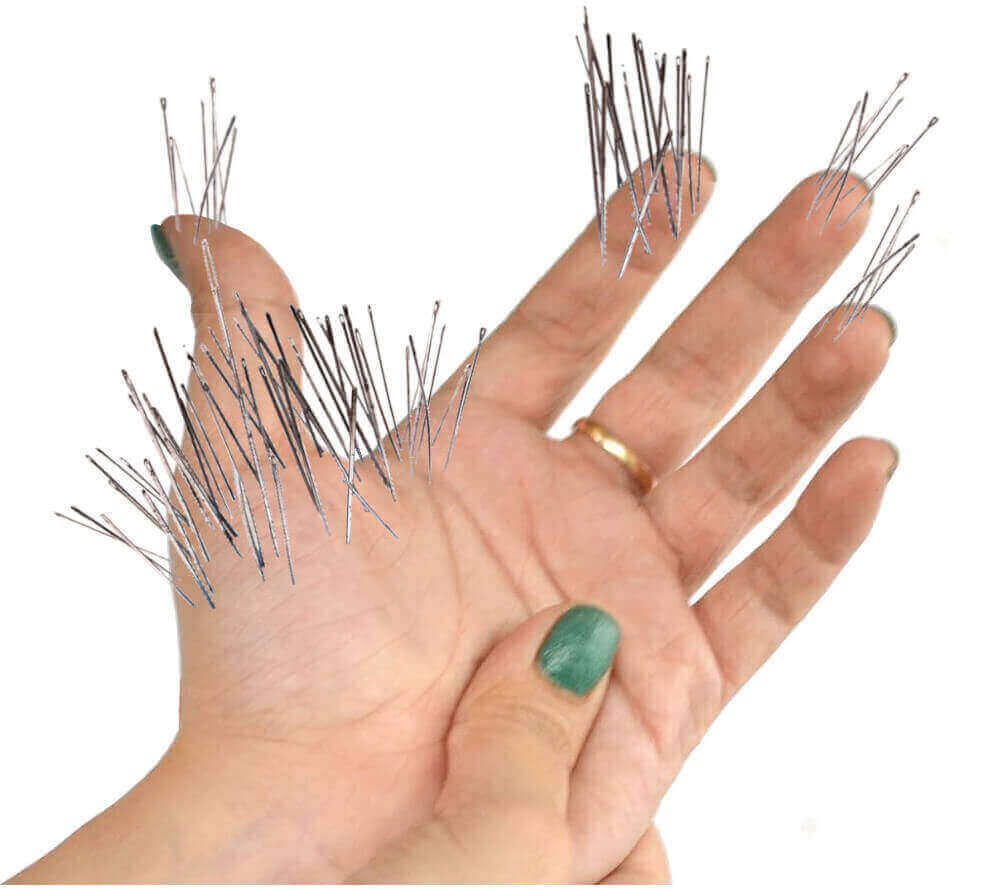What Does Carpal Tunnel Feel Like?
From Dr. Z - Carpal tunnel syndrome specialist
What Does Carpal Tunnel Feel Like?
Every day a concerned patient calls saying, "I think I overworked my hands. What does carpal tunnel feel like?"
Symptoms of carpal tunnel syndrome (most just call it "carpal tunnel") are not the same in everybody. But generally speaking there are common signs to look for. The most frequently experienced sensations are pain, numbness, and tingling in the hand or fingers on the palm side.
When carpal tunnel is
mild, these symptoms feel more like an annoyance. But in the
severe stage, they're intense and totally disruptive to your entire life.
It's important to know that nothing - not even surgery - can “cure” carpal tunnel syndrome. That's because it's a progressive disorder that has no cure.
But you can treat carpal tunnel effectively so that symptoms don’t bother you anymore. In fact, many nonsurgical treatments can successfully manage your symptoms so well that they never appear again.
- FIND OUT: do you have carpal tunnel? No strings attached self-test.
What causes carpal tunnel symptoms?
All carpal tunnel symptoms have one thing in common. They happen because of tendon inflammation inside your wrist joint.
The inflammation occurs because adhesions form between tendons. The adhesions irritate the tendon sheaths or covers, causing moment restrictions. As a result, the body fills the irritated area with fluid to act as a cushion, much like a blister.
However, as fluid builds up it squeezes the adjacent median nerve. This is one of the major nerves of the hand. As the median nerve is squeezed and compressed more and more, the feelings of pain, numbness, and tingling begin.
Initially, what does carpal tunnel feel like?
The hallmark signs
Doctors call the following list of symptoms the "hallmark signs" of carpal tunnel syndrome. That's because you can be sure to have these sensations in your hand or fingers. The hallmark signs include one or all of the following:
- pain
- numbness
- tingling (pins & needles)
- weakness
The sensations occur on the palm side of the hand and fingers. But they never occur on the pinky finger. Also, they may travel up the forearm toward the shoulder.
These are by far the most common symptoms. But you might also have other sensations like shooting electric shocks, itching, soreness, puffy finger feelings, and clumsiness.
One of the most common symptoms of carpal tunnel is the need to shake out a numb or tingly hand in the middle of the night. Even though it doesn't help relieve the numbness or tingling much, you still feel like you must do it. Many people can't get a good night's sleep because of this.
How mild symptoms begin
Carpal tunnel symptoms are very specific. However, many people (even doctors) confuse those symptoms with wrist tendinitis. That’s why it’s important to see a carpal tunnel doctor who knows this condition well.
In the beginning, symptoms generally are felt only when the hand is at rest. Symptoms are most noticeable during night while sleeping. In fact, waking up at night and losing sleep is a common patient complaint.
Usually, carpal tunnel symptoms begin gradually. They progress over many weeks and months and, in some cases, years. As the disorder advances, carpal tunnel symptoms also are felt during the daytime, while the hand is working.
In instances where your occupation is the cause of the disorder, symptoms will appear during the day when using your hand to perform your job's requirements. At home, symptoms usually appear during the day while doing simple tasks like holding a phone, tying s shoelace or driving.
It's important to stress that carpal tunnel symptoms never occur in the little finger. That's a main distinguishing feature of carpal tunnel syndrome from tendonitis. Also, symptoms usually are worse (more intense) at the base of the thumb and pointer finger.
In order to treat properly, it's important for patients and doctors to distinguish carpal tunnel syndrome from wrist tendonitis. When symptoms first appear, the main way you can tell between the two conditions is:
- Tendinitis is usually worse while your hand is active.
- Carpal tunnel symptoms usually occur when your hand is at rest.
Also, if symptoms are present in just one hand, then 80% of the time they will happen (within 6 months) in the other hand as well. This is called bilateral carpal tunnel syndrome.
Telling the difference between carpal tunnel and tendonitis is key to getting the right treatment. I developed a simple self-test to tell the difference here.
Pain
Finger or hand pain is one of the most common symptoms of carpal tunnel syndrome. As a matter of fact, patients usually first seek medical attention when they feel increasing or intense pain they just can't get rid of.
The pain can be felt anywhere on the palm of the hand. It's most prevalent on the thumb, especially at the thumb's base. Sometimes only the fingertips feel painful.
Pain is felt differently from person to person. It can be stabbing, dull or throbbing. It can also be constant or intermittent. Also, carpal tunnel pain may radiate up the forearm toward the shoulder. It may even feel like a shooting electric shock.
Numbness
Numbness is another common sign of carpal tunnel syndrome. Usually, numbness will first appear at night while you're trying to sleep.
As the disorder worsens, gripping an object like a coffee cup or holding a phone will make numbness appear during the daytime. Gradually, as the disorder advances you notice numb fingers and hands while doing other tasks. The tasks might seem unrelated (like making a bed or chopping vegetables).
Tingling
Tingling or pins & needle generally increase in intensity in proportion to the other symptoms as carpal tunnel advances. However, in more advanced states, tingling generally gives over to numbness.
Like numbness, tingling will also begin to show up while you're trying to sleep. As it advances into the daytime, it will occur when grasping, lifting, or straining your hand.
Weakness
More severe carpal tunnel syndrome often results in even more profound hand strength disability. It's actually a primary complaint (after pain or numbness) with some patients.
Loss of hand strength is usually experienced simultaneously with having hand "clumsiness". All this means that hand and finger dexterity is deteriorating. You may first notice the problem when buttoning your shirt or tying shoelaces. Picking up a pencil, keys, or coins is difficult. Writing with a pen gets harder and harder. Weakness, numbness, clumsiness, and general loss of dexterity causes patients to drop things often.
What does carpal tunnel feel like when its advanced?
When a patient asks, "What does carpal tunnel feel like?" the answer always comes back to severity. Mild symptoms are nearly the same as severe symptoms. It's just that severe symptoms are a lot more intense. And you might feel a few other sensations, too.
In time and without treatment, carpal tunnel syndrome will progress. Pain intensifies greatly. Patients often use descriptive terms like "cruel" or "punishing" pain. Pain medicines simply won't work at this stage. And it's usually this intense and unrelenting pain that reduces a person's quality of life.
The affected hand usually gets even more numb. The numbness usually spreads to all fingers except the pinky finger. Patients describe the numbness as "crushing" or "in a vice". This is when patients often say, "It's so bad I want to cut my hand off."
Grip strength and dexterity continue to decline. Ultimately, fine dexterity is almost completely lost.
With severe stage carpal tunnel, patients generally begin losing the ability to feel hot or cold in the fingertips. In fact, finger burning and scalding around the kitchen stove is common among patients with severe stage carpal tunnel syndrome.
The condition of end stage carpal tunnel syndrome is the final phase of this disorder. It usually appears as wasting of the muscles at the base of your hand. In other words, the normally-plump thumb muscle becomes flat and wrinkled. At this point your thumb is nearly useless.
In a cruel irony, pain usually diminishes in the end stage. That's the good news. But the bad news is this pain decrease happens because the median nerve is effectively dead. Your hand is not very useful anymore because you can't grip or pinch objects. Most of the feeling on the palm side of your hand is now gone.
Summary
"What does carpal tunnel feel like?" The answer depends on the stage of the condition. Some of the most common carpal tunnel symptoms include hand and finger pain, numbness, tingling, and weakness. In time and without treatment, these symptoms will get worse as the condition progresses. That’s why it’s necessary to treat immediately. In fact, the earlier you treat, the more likely the treatment’s success.








